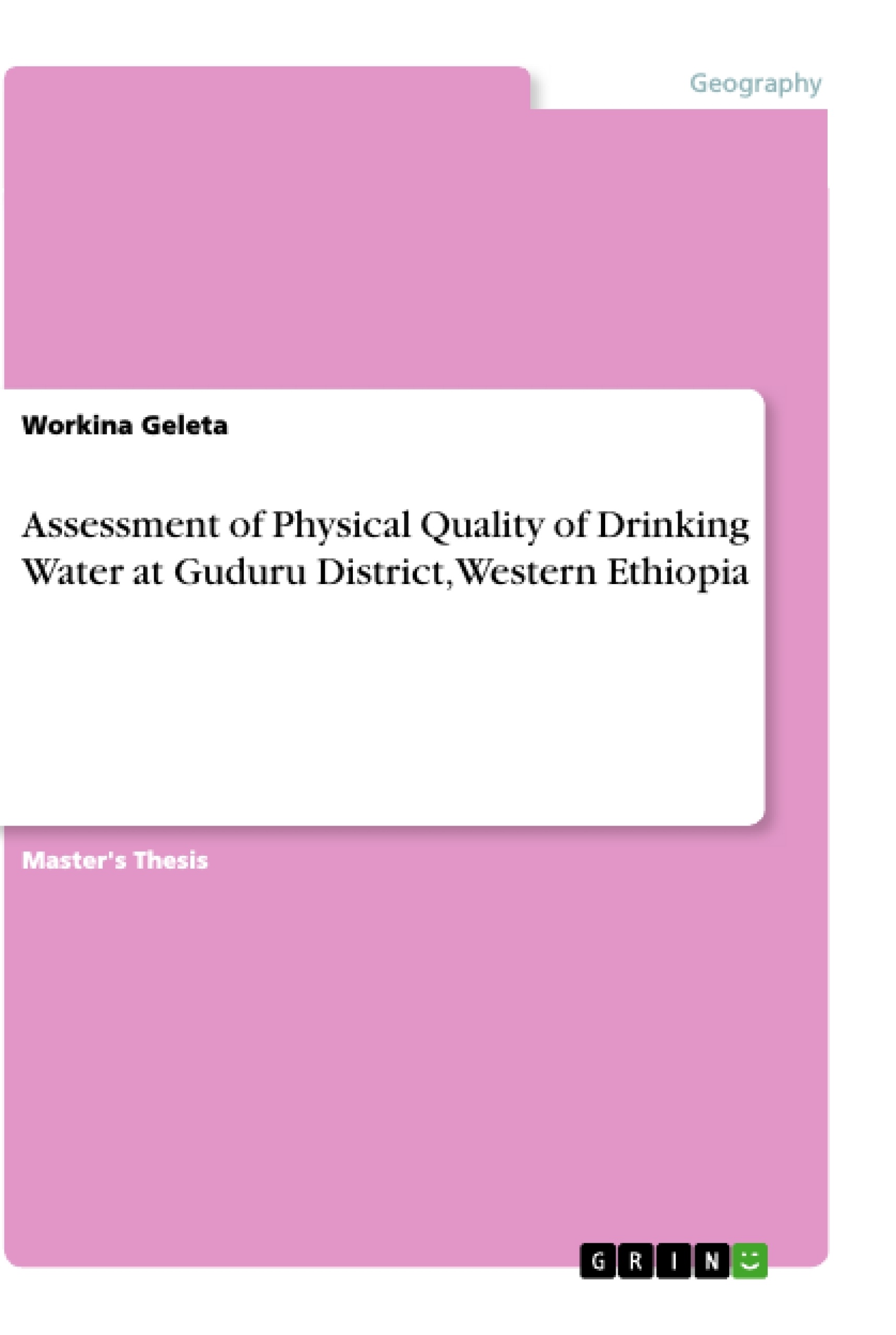A number of factors like geology, soil, effluents, sewage disposal and other environmental conditions in which the water stays or moves and interacts are among the factors that affect the quality of water. The sample of water was collected from six towns of Guduru district.
The objective of this study was to assess the physical quality of drinking water and suitability for drinking purpose. The physical water quality parameters examined by laboratory using standard procedure were temperature, pH, electrical conductivity (EC), turbidity, total dissolved solids (TDS), total suspended solids (TSS) and total solids (TS). ANOVA and mean
comparison were made to compare the difference between physically quality of tap water sample and well water. The study show that the mean values of tap water of temperature, pH, EC, Turbidity TDS, TSS, and TS ranged from 24.41 to 27.68°C, 7.35 to 7.52, 231.33 to 407.5 µS/cm, 1.5 NTU to 3.13 NTU, 154.77 to 273.02 mg/l, 56.33 to 223.78 mg/l, 211.12 to 496.83 mg/l, respectively and the mean values well water of temperature, pH, EC, Turbidity TDS, TSS, and TS ranged from 24.15 to 25.01°C, 7.35 to 7.55, 59 to 761.66µS/cm,1.01 NTU to 4.26 NTU, 39.5 to 510.32 mg/l, 5.92 to 321.7 mg/l, 45.45 to 832.11 mg/l, respectively.
From the result of physical parameter studied the temperature and turbidity of both tap water and well water fells the standards of drinking water which indicates not suitable for direct consumption. The electrical conductivity and total dissolved solid of Ayele well water results were above the recommended value of standards. This implies that water from most wells in
the study area is not in any way safe nor suitable for direct consumption. The increasing in TDS in Ayele well water might be due to increased amounts of inorganic and organic detritus from the surrounding environment in which the well exist. The highest value of TS at Ayele well water was due to high value of TDS and TSS in the town. Further study is initiated for
the sources of difference of physical parameters of tap and well water with in locations and along locations
Inhaltsverzeichnis (Table of Contents)
- Introduction
- Materials and Methods
- Study Area
- Study Design
- Data Collection Techniques
- Sample Collection and Laboratory Analysis
- Data Analysis
- Results and Discussion
- Socio-Economic Characteristics of the Study Area
- Physical Characteristics of Drinking Water
- Assessment of Water Quality Parameters
- Discussion
- Conclusion and Recommendations
- References
Zielsetzung und Themenschwerpunkte (Objectives and Key Themes)
This research project aims to assess the physical quality of drinking water in the Guduru District of Western Ethiopia. The study focuses on understanding the sources and quality of drinking water available to the local population. The research aims to provide insights into the factors influencing water quality and identify potential health risks associated with unsafe water consumption.
- Assessment of the physical quality of drinking water in Guduru District.
- Identification of the sources of drinking water and their characteristics.
- Analysis of the relationship between water quality parameters and potential health risks.
- Exploration of factors influencing drinking water quality in the region.
- Development of recommendations for improving water quality and reducing health risks.
Zusammenfassung der Kapitel (Chapter Summaries)
- Introduction: This chapter provides background information on the importance of safe drinking water and the challenges faced by the Guduru District in accessing it. It outlines the research objectives and the significance of the study.
- Materials and Methods: This chapter details the study area, research design, data collection techniques, sample collection procedures, and the methods used for laboratory analysis and data analysis. It describes the different methods used to assess water quality.
- Results and Discussion: This chapter presents the findings of the research, including the socio-economic characteristics of the study area, physical characteristics of the drinking water, and the assessment of water quality parameters. It compares the findings to existing standards and explores the potential implications for public health. It also discusses the factors contributing to the observed water quality issues.
Schlüsselwörter (Keywords)
The key terms and focus topics explored in this research include drinking water quality, physical parameters, Guduru District, Western Ethiopia, public health, water safety, and socio-economic factors.
- Citar trabajo
- Workina Geleta (Autor), 2015, Assessment of Physical Quality of Drinking Water at Guduru District, Western Ethiopia, Múnich, GRIN Verlag, https://www.grin.com/document/1031518



